A classic Japanese side dish, Hijiki Seaweed Salad features a type of wild sea vegetable that‘s packed with nutrients. Simmered with edamame and deep-fried tofu strips in a savory-sweet broth, this dish is full of flavor and perfect for meal prep. {Vegan Adaptable}
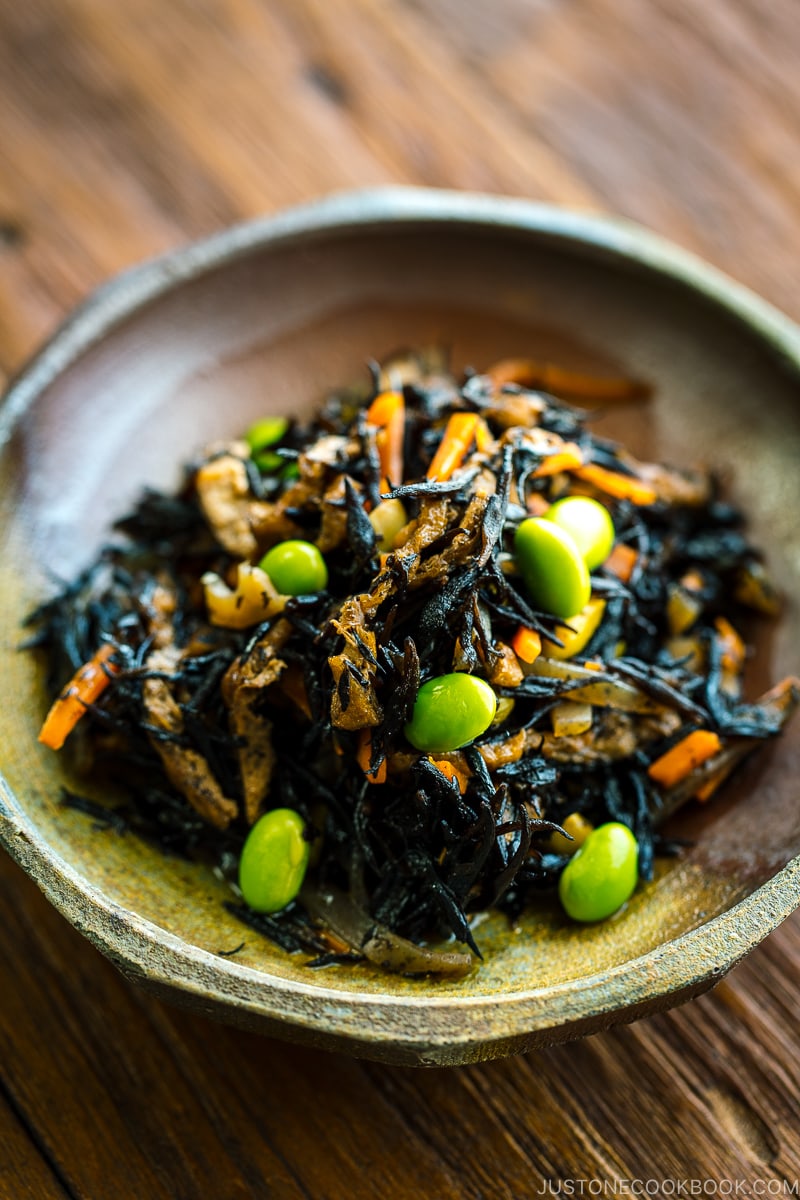
If you’re looking to include more sea vegetables into your diet, you’ll want to give hijiki a try. Resembling dried tea leaves but longer, hijiki is a type of wild sea vegetable that grows on rocky coastlines around Japan, Korea, and China. It has a sweet, clean taste and mushroom-like quality.
In Japan, we often enjoy it as hijiki no nimono (ひじきの煮物), which translates to “simmered hijiki.” It is technically a cooked dish, but you’ll find it called Hijiki Seaweed Salad at Japanese restaurants in the US.
Table of Contents
What is Hijiki Seaweed?
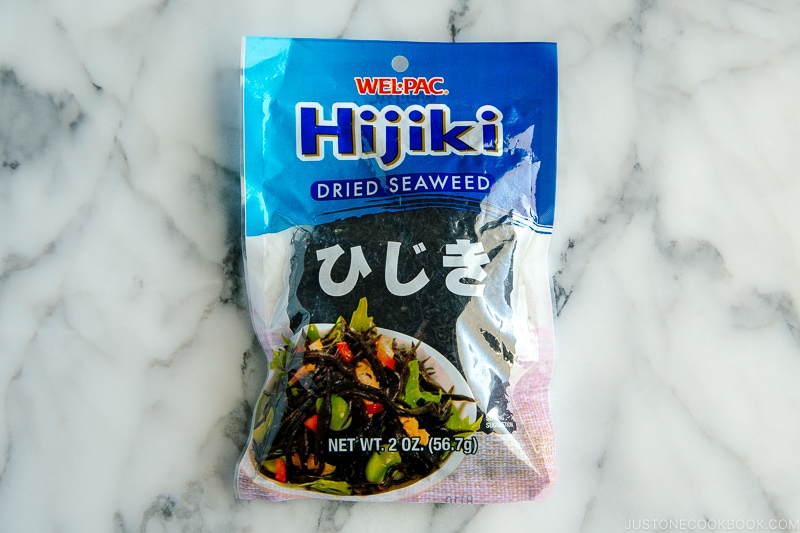
Hijiki seaweed is naturally green or brown in color when it’s hand-harvested by fishermen and divers in the wild. Before it’s packaged, hijiki is boiled and then dried, and this process turns hijiki black. You will need to rehydrate it by soaking it in the water prior to cooking.
Like other edible sea vegetables, hijiki is known for its dietary fiber and essential minerals like iron, calcium, and magnesium. After it’s cooked, it has a pleasant crunch and chewy bite. The taste is more earthy rather than oceany. The Japanese have been enjoying this traditional food as a part of a balanced diet for centuries.
Why You’ll Love This Recipe
- Great textures and flavors: It’s savory, sweet, and pleasantly crunchy
- Versatile: Serve this side dish in a Japanese dinner, lunch menu set, or bento box
- Meal-prep and freezer friendly: Make a big batch to enjoy throughout the week! It keeps in the fridge for 3–4 days or in the freezer for up to a month
- Packed with nutrients: Full of dietary fiber and minerals
Ingredients for Hijiki Seaweed Salad
You can leave out the optional ingredients, but hijiki salad always includes aburaage and edamame.
- dried hijiki seaweed – find it at Japanese supermarkets, Asian grocery stores, natural food stores, or online
- aburaage (fried tofu pouch) – adds protein and a lot of flavor
- carrot – adds color and nutrition
- edamame (young soybeans) – provides plant-based protein and a satisfying bite
- lotus root (renkon) – optional, but it adds a nice crunchy texture
- konnyaku (konjac) – optional; a jelly-like plant food unique to Japanese cuisine that’s very low in calories and high in fiber
- dashi – use homemade dashi, a dashi packet, or Vegan Dashi for vegan/vegetarian
- seasonings – soy sauce, mirin, and sugar
How to Make the Best Hijiki Seaweed Salad
There are various ways to prepare hijiki no nimono, but I really love my mom’s version. This is very close to how she cooks the dish.
- Soak the hijiki seaweed in plenty of water for 30 minutes. In the meantime, prep the other ingredients.
- Sauté the julienned carrots and sliced lotus root. Then, add the rehydrated hijiki, aburaage strips, and konnyaku strips.
- Add the broth and seasonings and simmer for about 30 minutes.
- Add the edamame and continue to simmer until the sauce cooks down and the ingredients soak up the simmering liquid.
- Cool to room temperature so the flavors mingle and settle in. Serve at room temperature.
Cooking Tips
- Season generously – When a dish is eaten at room temperature, you want to be generous with the seasonings so the flavors come through. Do not cut down on the sugar as we use it to balance the salt and enhance the overall taste.
- Don’t skip the fried tofu pouch – The sponge-like texture of the aburaage gives great depth, mouthfeel, and flavor to the dish, so don’t skip it.
- Make a big batch – Simmered hijiki is exactly the kind of dish that Japanese home cooks include in their meal prep. It keeps well and can easily enjoy throughout the week. You can mix it with white steamed rice to make Maze Gohan (Mixed Rice), add on top of soba noodles, or use it to make rice balls.
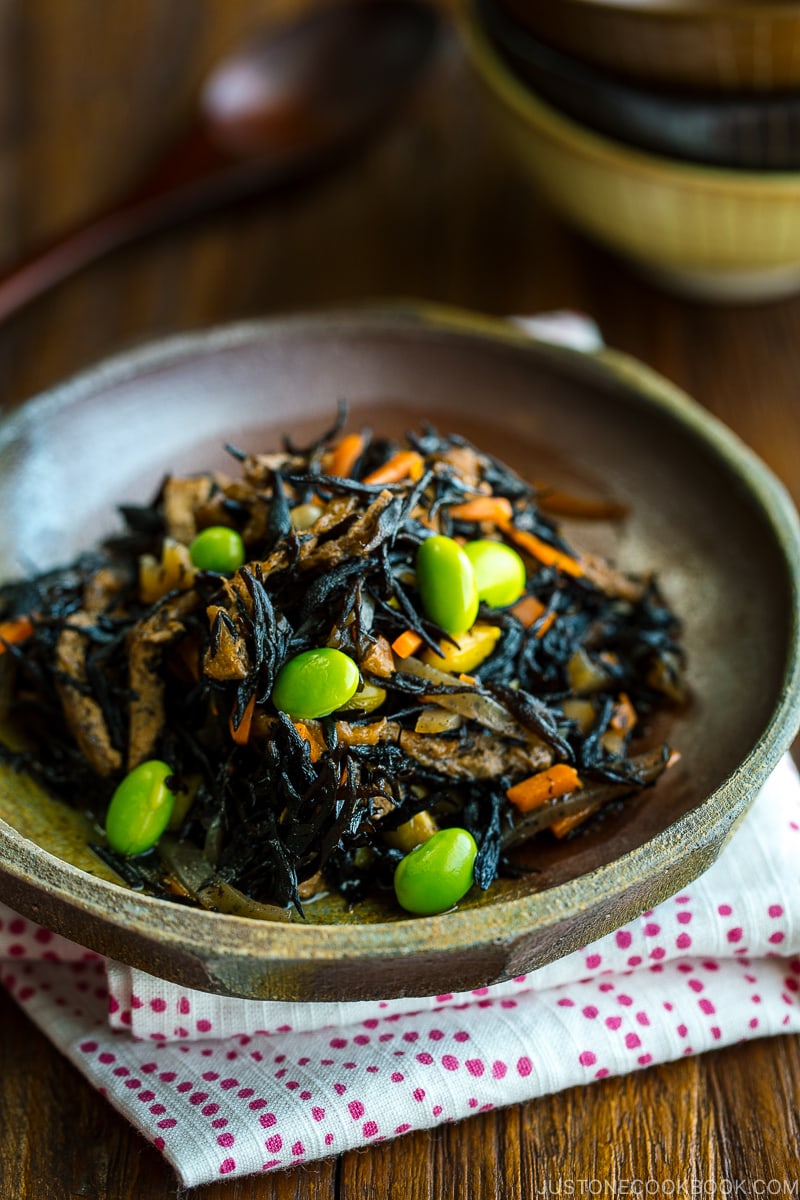
What to Serve with Hijiki Seaweed Salad
With contrasting textures and a concentrated sweet-savory flavor, Hijiki Seaweed Salad makes a truly unique Japanese dish that highlights the beauty of sea vegetables. I hope you enjoy it.
Try serving Hijiki Seaweed Salad with Grilled Mackerel, Japanese Spinach Salad with Sesame Dressing, White Steamed Rice, (Takikomi Gohan), and Miso Soup for a Japanese-style ichiju sansai meal.
Popular Similar Dishes
- Simmered Kabocha Squash
- Simmered Taro
- Simmered Koyadofu
- Simmered Bamboo Shoots
- Simmered Kiriboshi Daikon
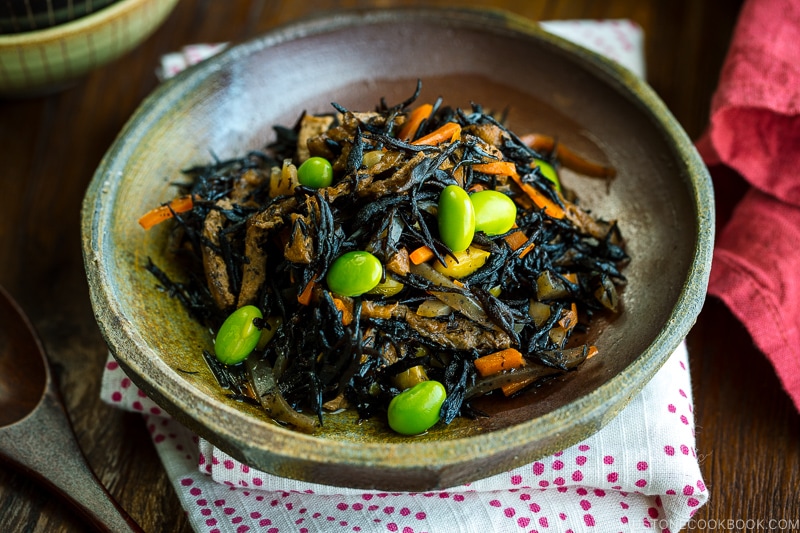
Wish to learn more about Japanese cooking? Sign up for our free newsletter to receive cooking tips & recipe updates! And stay in touch with me on Facebook, Pinterest, YouTube, and Instagram.
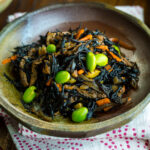
Hijiki Seaweed Salad
Video
Ingredients
- ½ cup dried hijiki seaweed (1 oz; increases tenfold after rehydration; I used mehijiki (芽ひじき), the small, soft “buds“ of the hijiki plant; you can also use the long and chewy “stems” called nagahijiki (長ひじき), which are less commonly found in the US)
- 4 cups water (for soaking)
- 2 aburaage (deep-fried tofu pouch) (1.4 oz, 40 g; you can substitute crispy fried tofu cubes from an Asian grocery store, but blanch them first to remove the excess oil)
- 3 oz konnyaku (konjac) (⅓ konnyaku block; optional)
- 3 oz carrot (½–1 carrot)
- ¼ lotus root (renkon) (1.3 oz, 37 g; pre-boiled; optional)
- 1 Tbsp neutral oil
- 2 cups dashi (Japanese soup stock) (use standard Awase Dashi, dashi packet or powder, or Vegan Dashi)
- ⅓ cup shelled edamame (2 oz, 60 g; cooked; optional)
Instructions
- Gather all the ingredients.
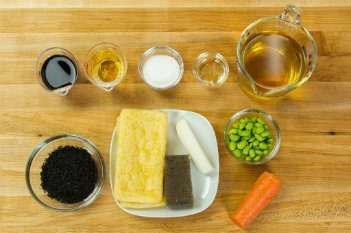
- Soak ½ cup dried hijiki seaweed in 4 cups water—10 minutes for mehijiki (bud hijiki) or 30 minutes for nagahijiki (stem hijiki). Meanwhile, prepare the other ingredients.
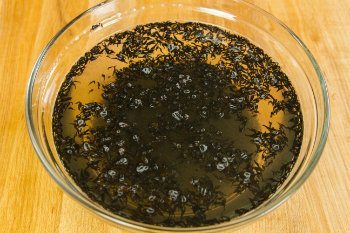
- Drain to a large fine-mesh sieve and rinse under running water.
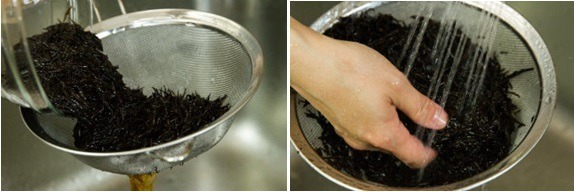
To Prepare the Other Ingredients
- Boil water in a small saucepan and pour it over 2 aburaage (deep-fried tofu pouch). This will remove the excess oil on the aburaage. Squeeze out the liquid. Then, cut in half lengthwise and thinly slice crosswise.

- Add some water and 3 oz konnyaku (konjac) to a small pot and boil for 3 minutes to remove the odor. This also helps the konnyaku absorb flavors and improves the texture. Then, slice it into small strips (about the same size as the aburaage slices).

- Cut 3 oz carrot into julienne pieces.

- Cut ¼ lotus root (renkon) into thin quarter pieces.
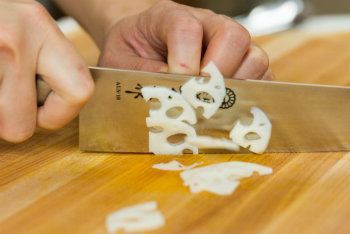
To Cook the Hijiki Salad
- Heat 1 Tbsp neutral oil in a medium pot over medium heat. Add the carrot and lotus root and cook until they are coated with oil.

- Add the hijiki, then the konnyaku and aburaage. Mix it all together.

- Add 2 cups dashi (Japanese soup stock) and let it boil.
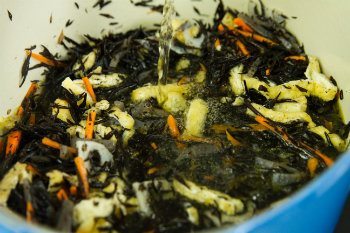
- Add all the seasonings: ¼ cup mirin, 2 Tbsp sugar, and ¼ cup soy sauce. Mix well. Cook covered on medium-low heat for 20–30 minutes.

- Add ⅓ cup shelled edamame.
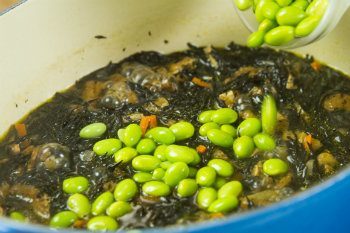
- Continue to cook, uncovered, to reduce the sauce until you see the bottom of the pan.
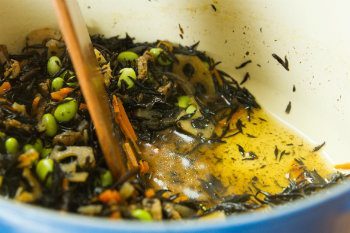
To Serve
- Serve as a side to a Japanese meal or pack in a bento lunch box. For convenient meal prep, you can divide the Hijiki Salad into a bento portion in silicone cups for freezing.
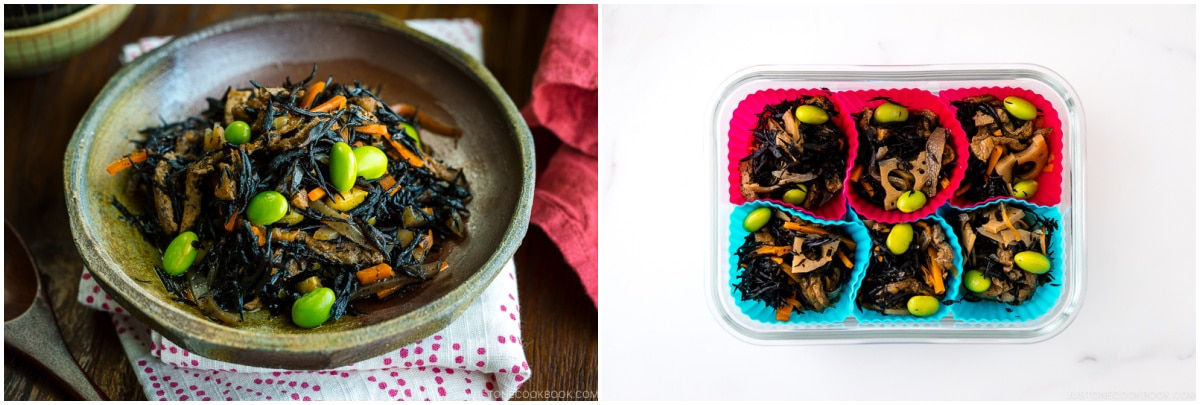
To Store
- Store in an airtight container and keep in the refrigerator for up to 3–4 days. You can also freeze it for up to a month.
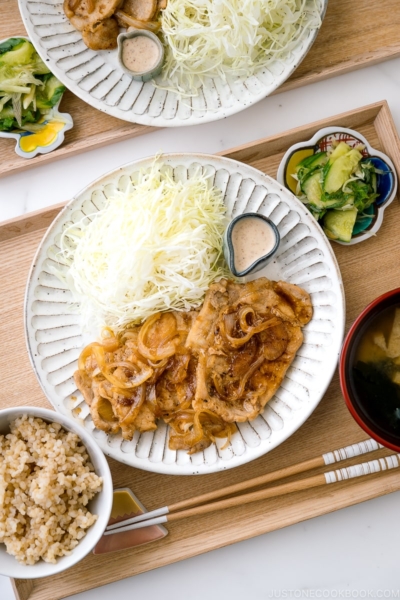
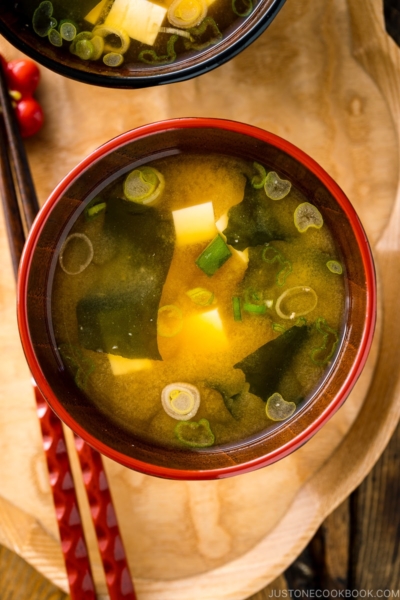

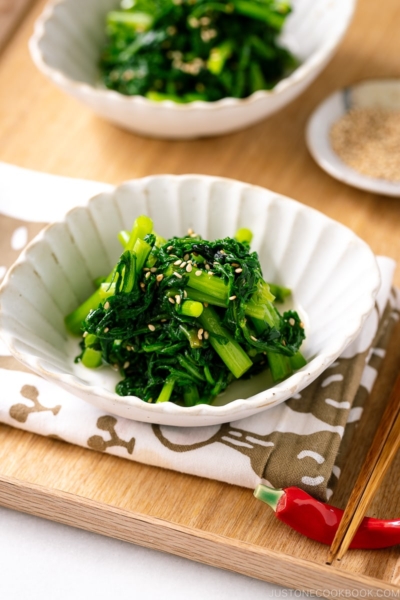
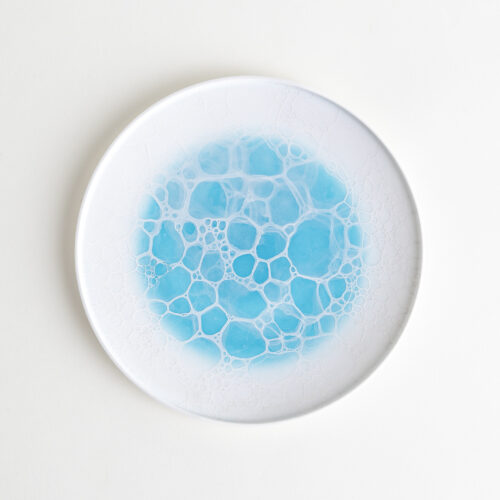
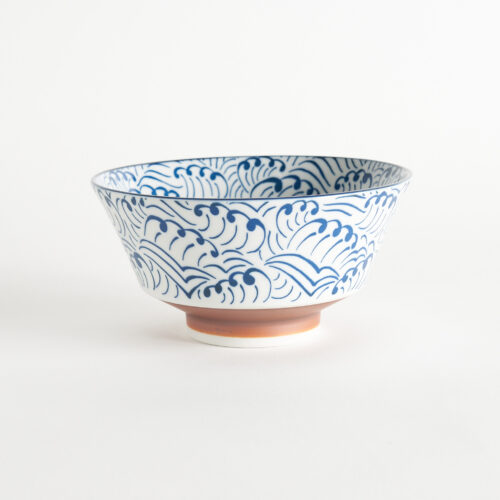
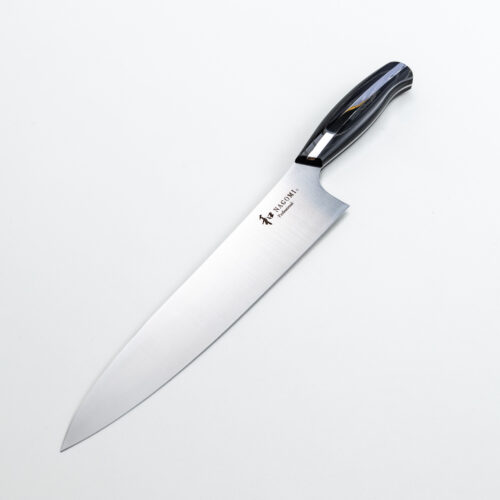
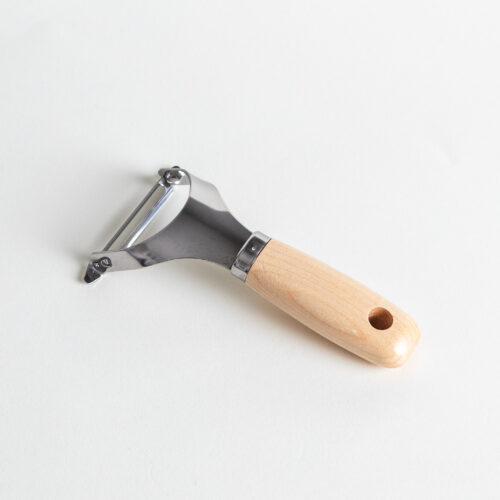
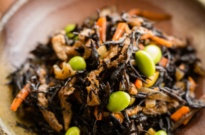
I followed the 3x recipe so I could have it throughout the week. added the shiitake mushrooms (thinly sliced) I used to make the vegan dashi, cut the sugar in half and only used 4 C of dashi – delicious!!!!!
Hello, Michele! Thank you for trying Nami’s recipe.
We’re pleased to hear you modified the dashi amount for the triple recipe! 6 cups will be a bit excessive, especially for this recipe. Thank you for sharing your experiences!🤗
Thank you for the recipe! I just came back from my 3rd trip to Japan and the side dishes such as grilled mackerel, natto and hijiki are what I miss the most 🙂
I prefer keeping added sugar in check (*most home cooking seasoning is already a tad too sweet to my liking) so I completely omitted sugar, and it turns out good. On top of I sprinkled grilled baby anchovies (Tazukuri) on top. It was a great healthy snack!
Quick question. if I made a large batch, how long can I keep it in the refrigerator for? Thank you!
Hi Alex! We are happy to hear you enjoyed the dish!
You can store the leftovers in an airtight container and keep them in the refrigerator for up to 3–4 days. You can also freeze it for up to a month.
Thank you for trying Nami’s recipe!
I’ve got access to fresh hijiki here in Korea which is called tot (톳). Any idea of the ratio of fresh to dried hijiki I would use for this recipe?
Hello, Angelo. Thank you for trying Nami’s recipe.
Dried Hijiki normally expands to 8-10 times its weight. Nami used 30g for this recipe, so try 240g of fresh hijiki.
We hope this information is helpful!
Thank you so much, just the info I needed.
This looks great. I don’t have access to hijiki, but I understand that arame, which is available where I live, is related and can work as a substitute, though it is more delicate. I’d love to know if you think it would hold up to the long simmering and the seasonings?
Hi, Tom! Thank you for trying Nami’s recipe.
To prepare this with Arame, soak it for about 10 minutes. Cooking time can also be changed to roughly 10 minutes.
We hope this helped!